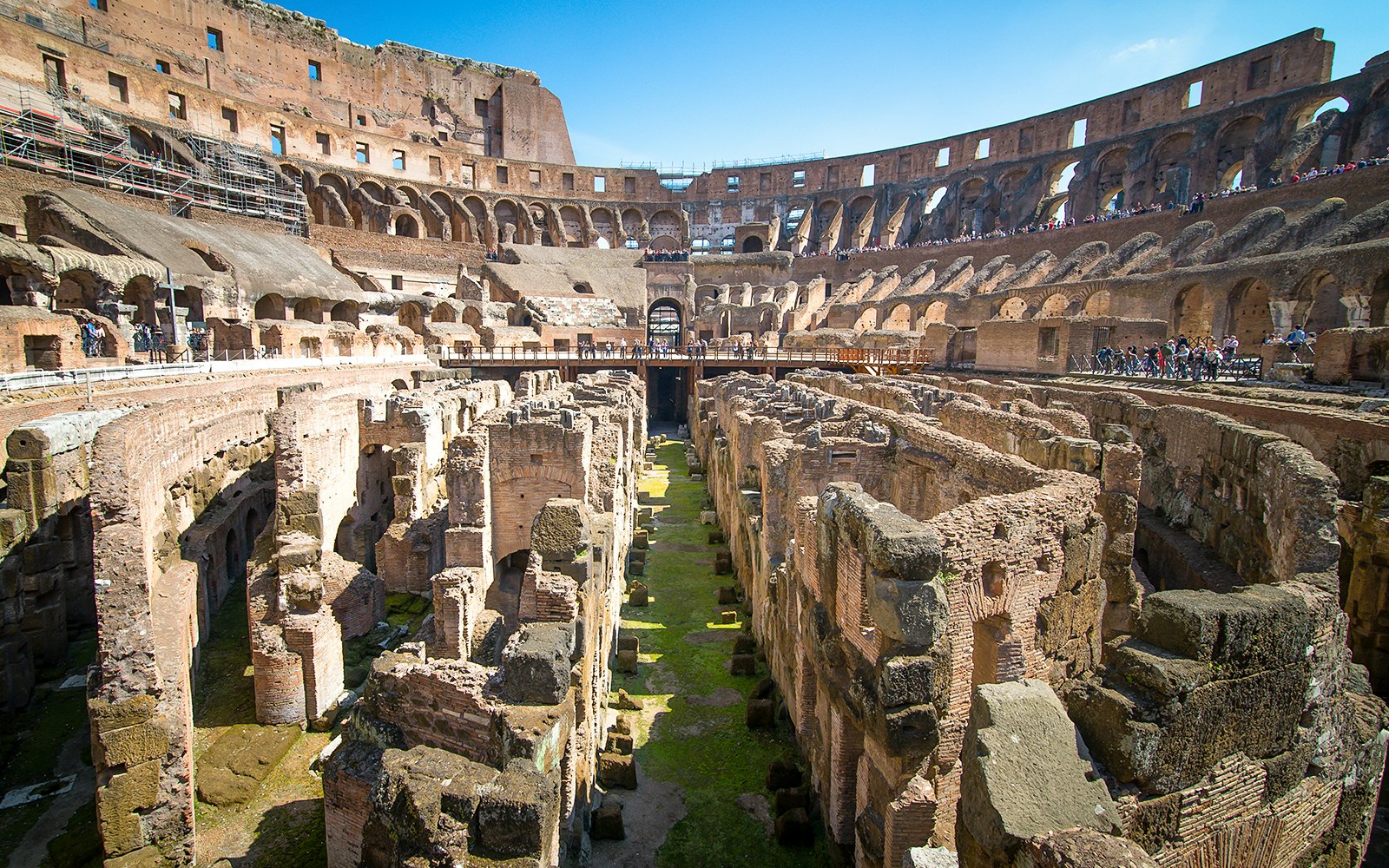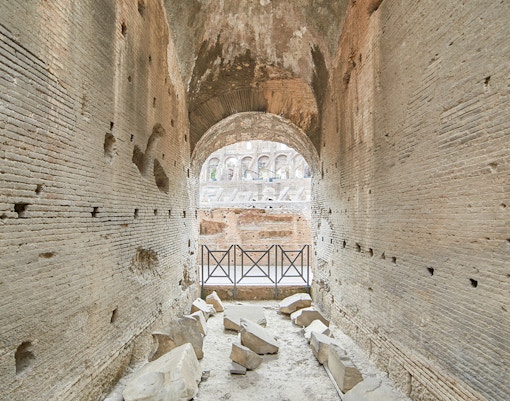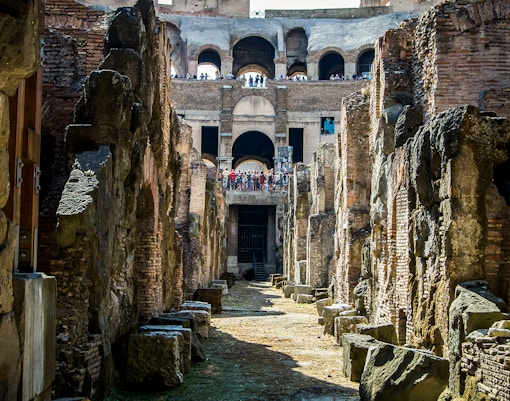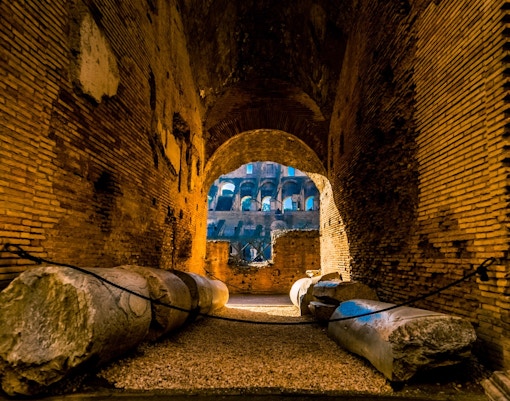Explorați cuștile animalelor, celulele gladiatorilor și lifturile din lemn. Fiecare spațiu dezvăluie tensiunea și anticiparea dinaintea bătăliilor, ghizii împărtășind povești pline de viață despre Dramă, pericol și intrări surprinzătoare în arenă.


Subteranul Colosseumului, sau hypogeum, era un labirint de tuneluri și celule sub podeaua arenei. Aici așteptau gladiatorii și animalele înainte de a fi ridicate în arenă pentru luptă. Hipogeul era echipat cu mecanisme pentru ridicarea oamenilor și a animalelor la suprafață.
Subteranul se află chiar sub podeaua arenei din Colosseum. Accesibilitatea este restricționată și disponibilă numai prin tururi ghidate de grup mic, care contribuie la conservarea sitului.
În subteran, sau Hypogeum - un labirint cu două niveluri - a început adevărata Dramă. Ascuns de ochii publicului, acesta servea drept culise ale marilor jocuri ale Romei. Întâlniți-vă cu ghidul dvs. și începeți la intrarea subterană exclusivistă a Colosseumului cu o scurtă prezentare istorică înainte de a coborî mai jos.




72-80 D.HR: Construcția Colosseumului începe sub împăratul Vespasian și este finalizată de Titus. Subteranul (hypogeum) este construit pentru a adăposti animale, gladiatori și mașini de scenă.
80-404 d.Hr.: Colosseum însoțește lupte de gladiatori, vânători de animale și spectacole elaborate. Subteranul devine centrul culiselor pentru spectacole complexe, folosind trape și lifturi din lemn.
Secolul al V-lea d.Hr: Odată cu declinul Imperiului Roman, spectacolele publice încetează. Colosseum - și subteranul acestuia - cade în neglijență și degradare.
Evul Mediu: Structura este reutilizată ca carieră. Pietrele sunt luate pentru alte clădiri romane. Subteranul este îngropat și uitat.
Secolele XVIII-XIX: Încep excavările, care readuc la lumină părți ale subteranului. Arheologii încep să descopere scopul și configurația sa inițială.
Secolul XX: Eforturi majore de restaurare vizează conservarea Colosseumului, inclusiv lucrări structurale la camerele subterane și tuneluri.
2010s: Colosseum subteran se deschide publicului prin tur ghidat, oferind o privire exclusivă, în culise, asupra celui mai emblematic amfiteatru din Roma.
Da, dar cu excepții. Tururile se desfășoară pe tot parcursul anului, dar pot fi întrerupte din cauza vremii nefavorabile, a lucrărilor de restaurare sau a evenimentelor exclusive.
Nu, subteranul este o zonă restricționată, accesibilă numai cu un ghid autorizat. Acest lucru este atât pentru siguranța vizitatorilor, cât și pentru conservarea zonei arheologice fragile.
Nu, nu toate biletele Colosseum includ accesul la subteran. Accesul la subteranul Colosseum necesită un bilet separat, care include un tur ghidat. Acest bilet include, de obicei, și accesul la restul Colosseum, Forumul Roman, și Dealul Palatin.
Poate fi. Așteptați-vă la poteci inegale, scări și locuri limitate. Este posibil ca aceste tururi să nu fie ideale pentru utilizatorii de scaune cu rotile sau pentru cei cu probleme de mobilitate. Purtați pantofi confortabili și verificați în prealabil detaliile privind accesibilitatea.
Da, dar mai potrivit pentru copii mai mari (8+). Copiilor mai mici li s-ar putea părea obositoare adâncimea istorică și mersul pe jos. Unele tururi oferă formate Prietenos pentru familii - fiți atenți la acestea dacă călătoriți cu copii.
Colosseum, inclusiv subteranul, a fost comandat de împăratul Vespasian din dinastia Flavia, dar hipogeul a fost adăugat mai târziu de împăratul Domițian.
Colosseum a fost construit între anii 70-80 d.Hr., dar subteranul a fost adăugat mai târziu, la aproximativ zece ani după inaugurarea arenei.
Alegeți un tur de grup mic (aproximativ 8-12 persoane) pentru o experiență intimă. Acest lucru vă oferă mai mult timp cu ghidul dvs., fotografii mai bune și mai puțini oameni în spații înguste.
Vizitatorii Colosseumului subteran pot explora tunelurile labirintice, pot învăța despre logistica organizării marilor jocuri gladiatorii și pot dobândi o înțelegere mai profundă a istoriei și culturii romane antice.
Categoric. Aceste tururi se vând rapid din cauza numărului limitat de grupuri și a cererii mari, în special primăvara și vara. Este recomandată rezervarea cu cel puțin 2-3 săptămâni în avans.
Singura modalitate de a accesa subteranul restricționat al Colosseumului, unde gladiatorii își așteptau soarta înainte de a lupta pe ringul arenei.
Elemente incluse
Tur ghidat cu acces special în subteran și la etajul Arenei
Tur ghidat al Colosseumului cu intrare rezervată
Ghid vorbitor de engleză, franceză sau spaniolă (conform opțiunii selectate)
Tur ghidat al Dealul Palatin și al Forumului Roman cu acces prioritar (conform opțiunii selectate)
Grup mic de maxim 6 persoane (conform opțiunii selectate)
Căști
Elemente excluse
Ce trebuie să aduceți
Ce nu este permis
Accesibilitate
Informații suplimentare
Intrare rezervată la Colosseum la ora pe care o alegeți, plus libertatea de a explora Forumul și Dealul Palatin în termen de 24 de ore.
Elemente incluse
Intrare cronometrată la Colosseum
Acces la Colina Palatină și la Forumul Roman
Audio ghid în engleză, spaniolă, franceză, germană, italiană, portugheză, chineză
Intrare asistată (conform opțiunii selectate)
Acces special la Arena Colosseum (conform opțiunii selectate)
Acces la Închisoarea Mamertină cu audio ghid (conform opțiunii selectate)
Elemente excluse
Ce trebuie să aduceți
Ce nu este permis
Informații suplimentare
Participă la un tur exclusiv al Arenei, câmpul de luptă al gladiatorilor, limitat la doar câțiva vizitatori pe rând.
Elemente incluse
Tur ghidat al Colosseumului, Dealului Palatin și Forumului Roman
Tur ghidat cu acces special la Arena Floor
Ghid vorbitor de engleză, spaniolă, franceză, portugheză, italiană sau germană (în funcție de opțiunea selectată)
Grup mic de 15 persoane (conform opțiunii selectate)
Intrare cronometrată la Colosseum
Căști
Ce trebuie să aduceți
Ce nu este permis
Accesibilitate
Informații suplimentare
Rezervați acum fără niciun avans. Anulați gratuit dacă vi se schimbă planurile.
Rezervați acum fără niciun avans. Anulați gratuit dacă vi se schimbă planurile.
Puteți anula aceste bilete cu până la 7 zile înainte de începerea experienței și veți primi o rambursare integrală.
Rezervați acum fără niciun avans. Anulați gratuit dacă vi se schimbă planurile.